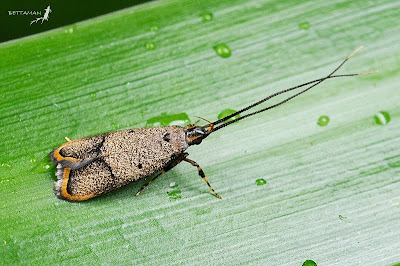 文獻來源: Kaila L, Mutanen M, Nyman T. 2011. Phylogeny of the mega-diverse Gelechioidea (Lepidoptera): Adaptations and determinants of success. Molecular Phylogenetics and Evolution 61(2011): 801-809.
文獻來源: Kaila L, Mutanen M, Nyman T. 2011. Phylogeny of the mega-diverse Gelechioidea (Lepidoptera): Adaptations and determinants of success. Molecular Phylogenetics and Evolution 61(2011): 801-809.Abstract
The Gelechioidea, with 18,000 described and many more unnamed species ranks among the most diverse lepidopteran superfamilies. Nevertheless, their taxonomy has remained largely unresolved, and phylogenetic affinities among gelechioid families and lower taxa have been insufficiently understood. We constructed, for the first time, a comprehensive molecular phylogeny for the Gelechioidea. We sampled seven genes, in total 5466 base pairs, of 109 gelechioid taxa representing 32 of 37 recognized subfamilies, and two outgroup taxa. We used maximum likelihood methods and Bayesian inference to construct phylogenetic trees. We found that the families Autostichidae, Lecithoceridae, Xyloryctidae, and Oecophoridae s. str., in this order, are the most basally arising clades. Elachistidae s. l. was found to be paraphyletic, with families such as Gelechiidae and Cosmopterigidae nested within it, and Parametriotinae associated with several families previously considered unrelated to them. Using the phylogenetic trees, we examined patterns of life history evolution and determinants of the success of different lineages. Gelechioids express unusually wide variability in life-history strategies, including herbivorous, saprophagous, fungivorous, and carnivorous lineages. Most species are highly specialized in diet and other life history traits. The results suggest that either saprophagy was the ancestral feeding strategy from which herbivory evolved independently on multiple occasions, or that the ancestor was herbivorous with repeated origins of saprophagy. External feeding is an ancestral trait from which internal feeding evolved independently several times. In terms of species number, saprophages are dominant in Australia, while elsewhere several phytophagous lineages have extensively specialized and diversified. Internal feeding has remained a somewhat less generally adopted feeding mode, although in a few lineages significant radiations of leaf mining species have occurred. We conclude that diverse feeding modes, specialization among saprophages, repeated shifts to phytophagy, and a generally high specialization rate on single plant species (monophagy) are the major factors behind the success of the Gelechioidea.
圖片拍攝: 吳士緯
